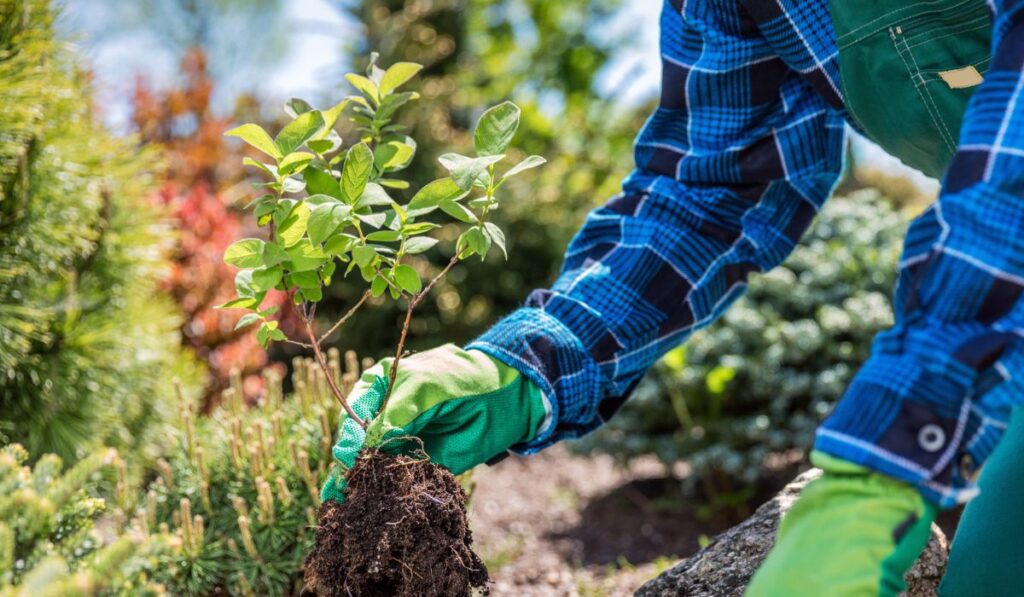Trees are an investment, and it helps to think of them as the lungs of our beautiful planet. With some luck and good timing, a tree may survive if you stick it into the ground and walk away. However, you can enjoy repeated success if you know how to plant a tree the right way, and here’s what to know about it:
The best time to plant new trees is in the fall after leaf break or early spring. Ensure the tree is best suited for the climate and conditions of the new site. Monitor the newly planted trees for any signs of distress and make necessary adjustments to ensure they thrive.
You might want to plant as many trees as possible once you appreciate their benefits. And whether you’re a newbie in this or a veteran with a forest to your name, we’re always learning. Let’s get started so you figure out how to plant new trees correctly.
When is the Best Time to Plant a Tree?

The best time to plant a new tree is in the fall after leaf drop and before bud break in early spring.
The weather conditions must be sufficiently cool to allow time for the new trees to establish roots in their new location. The spring rains and summer heat will then come in handy to encourage new top growth.
While the ideal times for planting new trees are fall and early spring, you can plant healthy balled-and-burlapped (B&B) or container trees throughout the growing season. This goes as long as there’s sufficient water.
Moreover, unlike the tops of decorative plants that stop growing and go dormant for the winter, healthy B&B trees continue to grow throughout the warmer months of fall and winter.
Why is This?
As it turns out, fall planting allows carbohydrates from the previous season to go into root development as there’s little demand from the top. This is also why the plant may need less supplemental irrigation in the subsequent summers.
How to Pick the Right Tree for You
While trees are an excellent addition to any landscape, not all trees will do well in any site or climate. Therefore, proper selection and placement are critical decisions you should make when landscaping or replacing a tree—more of “right tree, right place.”
Matching the tree to its site is not only beneficial for the tree, but it’s also helpful for you and the community at large. So here are the four critical factors to consider when choosing the right tree for you:
Location
Pick an appropriate planting spot no less than 15 feet from buildings. This way, the branches, and roots will have enough “breathing space” without interfering with surrounding infrastructure like sidewalks and power lines.
And dial 811 a few days before digging so utility companies can help you identify and mark underground utilities.
Tree Function
Various trees serve different functions—that’s a no-brainer. For example, a deciduous shade tree will cool your home in the summer and allow the winter sun to heat your home when it sheds its leaves.
On the other hand, an evergreen tree offers you a reliable windbreak or privacy screen. And if you have fruit trees, you have a chance to blend healthy, natural juices.
Tree Form and Size
Choosing an appropriate shape (form) to complement the desired function will significantly help minimize maintenance costs and improve the tree’s value in your yard.
You can safely plant low-spreading trees under overhead utility lines, something you can’t dream of with tall, tall evergreens, however narrow they are. Moreover, mature trees have the most economic value and have significant environmental returns.
Selection
Since each tree has specific soil, sunlight, and water requirements, you should choose one that thrives in your selected location. A tree that does well in dry soils will likely die if you plant it in poorly drained soil.
Tolerance
Think locally and conduct more research to determine the kind of trees that thrive in your region. Then, choose a hardy enough tree to withstand adverse conditions like intense heat, prolonged droughts, or pests and diseases that may be common in your zone.
You can leverage helpful tools like the USDA Plant Hardiness Zone Map to help you identify your planting zone. Since climate change is quickly affecting these zones, you could use more advice from a local arborist.
How to Plant a Tree
You can quickly establish your favorite tree in its new location by following these simple steps:
- Dig a broad planting hole that’s only as deep as the root ball but twice as wide as it is.
- If the root ball has a wrapping, carefully remove it to encourage seamless root growth. Cut off a couple of rings or remove the entire wire basket, so it doesn’t mess with future root development.
- Check around the root ball for circling roots and cut them off if you can’t straighten them.
- Plant the tree at the proper height, ensuring the trunk flare remains partially visible. Remember, the trunk flare is where the trunk expands at the tree’s base, and you should remove excess soil before planting if you can’t see it.
- Before you fill the hole, let someone check the tree from multiple angles to ensure it’s straight. Next, fill the hole gently while ensuring it’s firm. Most of the tree’s roots will form in the top 30 cm (12 inches) of soil, meaning you shouldn’t plant too deep.
- As you pack soil around the base of the root ball, you’re stabilizing the tree and eliminating air pockets simultaneously. Watering the tree periodically while backfilling will help eliminate more air pockets.
- Lay a good mulch cover around the base of the tree and keep it 2 inches away from the tree trunk. This prevents the trunk from getting moist and decaying.
Maintain follow-up care to ensure the tree grows healthily until it’s well established. Water it at least once a week to keep the soil moist, and do it more frequently during hot, windy weather.
You should maintain the watering routine until mid-fall when the temperatures are low enough and there’s less evaporation.
Should You Mulch a New Tree?
You should carefully mulch a new tree to retain soil moisture, eliminate weeds, and moderate soil temperatures. Moreover, it helps reduce the erosion of raised soil around the newly planted trees. Organic mulch also breaks down and adds nutrients to the soil.
Start about 2 inches from the trunk and apply 3 to 4 inches of organic mulch around the plant. This will help reduce the chances of stem rot. You can use mulch material consisting of ground hardwood bark, pine needles, wood chips, or shredded leaves.
Tips and Tricks for Planting a Tree

These are the additional tips and tricks that are helpful for your newly planted trees:
- Delay corrective pruning until the tree has enjoyed a full season of growth. You may prune sparingly if you notice some branches have been damaged during the planting process.
- If you need to wrap the trunk, wrap it carefully from the bottom with biodegradable materials.
- Water the plant properly with slow and deep irrigation until it’s established. For best results, put the watering on auto-pilot, as it’s not practical to do this by hand. Your best bet is to use soaker hoses or drip irrigation. And if you combine these portable battery-operated timers, you can enjoy tremendous time-saving benefits.
- Transplant shock may affect balled-and-burlapped trees and container plants. It’s a state of reduced growth and vitality, which can occur when the plants have lost a good chunk of their root system. Prepare the new planting site well and handle the trees carefully during transplanting to avoid inflicting further damage on the roots.
- If you’re planning to use fertilizer, only do so when the tree has adapted to its new environment through successful establishment. Experts recommend using a slow-release organic fertilizer that won’t burn the plant roots.
- Monitor the newly planted trees for further signs of distress and make necessary adjustments to ensure they live a long, happy life.
